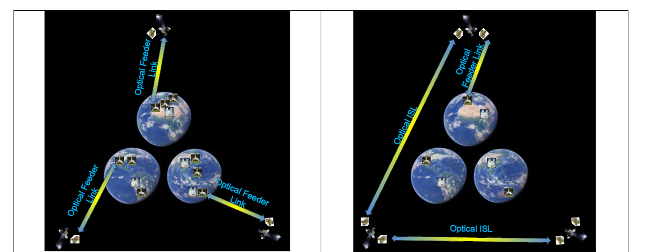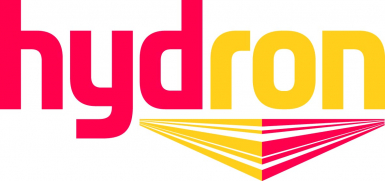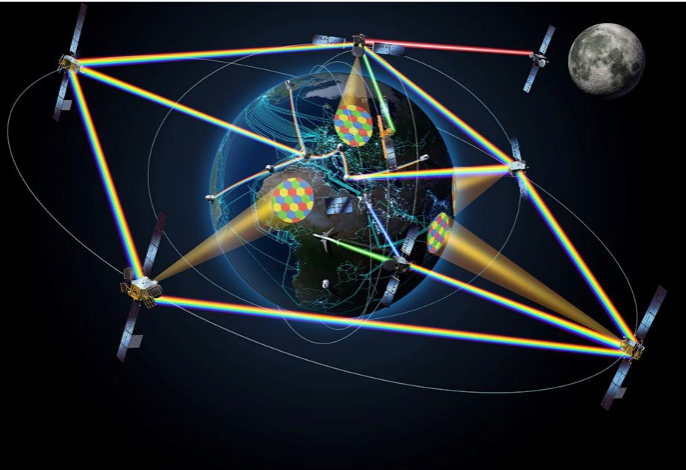Terrestrial data transport networks (Fibre Networks) are key for “Enabling the Fourth Industrial Revolution”, but these terrestrial networks have limitations in terms of deployment and end user service capacity.

Today, the space industry is investing in Very High Throughput Satellites (VHTS) and mega-constellations, which are aiming to complement (and even compete) with terrestrial fibre networks.
While it is standard that terrestrial networks are reconfigurable in real time to allow faster transmission of higher data volume, or to allow re-routing data when lines are overloaded or broken, current space solutions are somewhat isolated implementations. As a result, these space solutions are not very effective for a ground network operator as the connection cannot be reused/re-configured like in terrestrial network concepts.
Very high throughput space solutions in GEO/LEO orbits require an extensive ground station network, which needs to be extended if an increase of data service capacity or connection speed/bandwidth is envisaged.
In addition, the limitation of the RF bandwidth/frequency spectrum for up- and download of user data and via feeder links is becoming more and more a bottleneck for the extension of the services. Regulatory aspects also play an important role. As a result, often the required bandwidth cannot be granted in all regions.
To overcome this limitation, optical connections replacing the feeder up/downlinks and free part of the RF spectrum can be an attractive solution. On top of that, optical communication can provide higher data link capacities.
However, optical signals also have limitations due to the Earth’s atmosphere – in the simplest form as clouds, causing the need for a site diversity concept with multiple optical ground stations.
If every satellite, in isolation, would use the same approach, the deployment of the optical ground station infrastructure would be massive.
What is required is a more flexible, reconfigurable and seamless integrated solution.
Instead of deploying a network of optical ground stations for every single deployed satellite, satellites could form a space network of interconnected satellites themselves by high capacity inter-satellite optical links.
In case of bad weather conditions over an optical ground station, the data could then be up/downloaded via another optical ground station linked to this network and routed via other satellites in the space network to the particular user – even if on the other side of the globe.

The capacity of an optical connection is even large enough to serve multiple satellites at the same time. Each satellite only uses part of the data stream while the rest is routed to the next one or to ground.
HydRON – High ThRoughput Optical Network

The overall objective or mission statement of HydRON is to demonstrate:
“Fibre in the Sky” technology integrated in terrestrial networks at Terabit capacity demonstrated by
European and Canadian Industries by 2025.Mission Statement

The phrase “Fibre in Sky” has been stressed many times over the last decades, but only recent developments of optical & opto-electronic technologies have shown that an implementation of optical networks in space, including network flexibility (due to routing) and cost per byte of data, seem feasible.
HydRON will develop the world’s first (all) optical transport network at terabit capacity in space, by extending terrestrial fibre-based networks seamlessly into space. The concept overview is depicted in Figure 1.
The “Fibre in the Sky” concept will allow to serve the space network from many sites around the globe and therefore will provide the means to:
- Reduce the dependence of terrestrial infrastructure, like satellite-specific (optical or RF) ground stations.
- Benefit from switching capabilities on board the satellite to re-route data traffic.
- Overcome atmospheric dependencies for optical feeder up/downlinks due to the interconnection and therefore ease the use of optical communication for space application.
The HydRON concept is a priori not orbit specific. The same approach for implementing an optical transport network in space can be applied to GEO-based telecom missions (e.g. VHTS ) and/or to LEO/MEO-based telecom missions (e.g. satellite mega-constellations with meshed topology), or even to a mixed LEO/MEO/GEO scenario.
HydRON Benefits
HydRON can provide the networking layer to connect “all space assets” to the network (internet). This can be extended even to interface with interdisciplinary missions, like deep space science missions or lunar missions (Deep Space gateway – ESPRIT Module) to be connected to Earth.
Benefits for Satellite Operators
Like on Earth, the interconnection of multiple players in space has the potential to create new applications and new cooperation/business opportunities or operational benefits.
Especially for Satellite Operators, the “Fibre in the Sky” will:
- enable optical up/down link capabilities (Terabit/s);
- eliminate the need to deploy dedicated optical ground stations;
- eliminate the need to deploy dedicated site diversity concepts;
- allow flexible routing of data within the operator’s fleet or with satellites of other operators;
- allow full integration into terrestrial networks and cooperation with terrestrial network operators (e.g. for 5G).
Benefits for Terrestrial Network Operators
For Terrestrial Network Operators, the “Fibre in the Sky” concept will place satellite solutions not just at the far end of their network, but makes the satellite an integrated element of the network (effectively a network node). This will allow for:
- Load balancing and backhauling of traffic (e.g. for trans-Atlantic networks);
- Flexible load balancing during high-demand events (e.g. 5G during a football championships and similar large scale public events);
- Network extension into rural areas with similar switching and capacity means like terrestrial deployments (longer term replacement of fibres – not just gap fillers);
Benefits for Manufacturers
HydRON will provide the programmatic framework to industry to develop and demonstrate their capabilities and can be seen as a showcase for Optical Communications Networks and the vision of a “Fibre in the Sky”.
HydRON will develop and finally demonstrate the capabilities of multiple industrial players and to prepare the technologies and their stakeholders for the future.
Thanks to HydRON, the suppliers of payload/ground/network elements will be at forefront of the space optics competitive landscape.
HydRON will foster the implementation of the Optical Roadmap (as defined in the Strategic Plan of the SPL Optical Communication – ScyLight) to ensure European and Canadian industrial capabilities in the areas of:
- Intra-Satellite Photonics;
- Optical terminals (Space and Ground);
- Optical Network Concepts.


